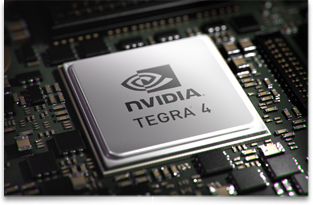Nvidia has just announced the launch of its newest System On Chip for mobile devices. Successor to the Tegra 3, the obviously named Tegra 4 chip is claimed to be faster then current competition and is aimed at keeping Nvidia remain competitive in the highly competitive mobile segment. Based on the ARM Cortex A15 architecture, the SoC also integrates 72 GPU cores.
The Tegra 4 was unveiled at a press conference at the International CES by Nvidia CEO Jen-Hsun Huang who remarked; “This thing is flooded with GPU cores”. To demonstrate how faster than competition the Tegra 4 actually is, he pitted the chip against the current speed king, the Google Nexus 10. A prototype Tegra 4 based tablet was placed side by side and both the devices were made to load 25 high traffic websites. While the Nexus 10 took a leisurely 50 seconds to open them all, the Tegra 4 based device wrapped the test in under 27 seconds.

The Tegra 4 is also claimed to help photographers take HDR images easily. HDR imaging and processing on a mobile device is a processor intensive task the likes of the iPhone is decently capable of doing it. The iPhone 5 currently takes just 2 seconds to capture an HDR image. Tegra 4 claims to be faster and according to Huang, HDR images can be captured without any delay at all. “It basically is a one-shot HDR,” he said. “Whatever you can take with one exposure, you can now take in HDR.”
Nvidia’s previous release, the Tegra 3 had seen moderate success and was seen on handsets and tablets including the Nexus 7, Microsoft Surface and the Transformer from Asus. That chip was however based on the 40-nanometer manufacturing process which was simplay not enough to match Qualcomm’s 28 nanometer Snapdragon S4 chip – Nvidia’s chief rival.
While initial impressions of the Tegra 4 look impressive, it would only be a while before we get to know how well it compares to Qualcomm’s upcoming chipsets.




